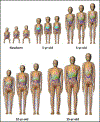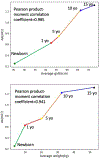Current pediatric administered activity guidelines for 99m Tc-DMSA SPECT based on patient weight do not provide the same task-based image quality
- PMID: 31448427
- PMCID: PMC7080403
- DOI: 10.1002/mp.13787
Current pediatric administered activity guidelines for 99m Tc-DMSA SPECT based on patient weight do not provide the same task-based image quality
Abstract
Purpose: In the current clinical practice, administered activity (AA) for pediatric molecular imaging is often based on the North American expert consensus guidelines or the European Association of Nuclear Medicine dosage card, both of which were developed based on the best clinical practice. These guidelines were not formulated using a rigorous evaluation of diagnostic image quality (IQ) relative to AA. In the guidelines, AA is determined by a weight-based scaling of the adult AA, along with minimum and maximum AA constraints. In this study, we use task-based IQ assessment methods to rigorously evaluate the efficacy of weight-based scaling in equalizing IQ using a population of pediatric patients of different ages and body weights.
Methods: A previously developed projection image database was used. We measured task-based IQ, with respect to the detection of a renal functional defect at six different AA levels (AA relative to the AA obtained from the guidelines). IQ was assessed using an anthropomorphic model observer. Receiver-operating characteristics (ROC) analysis was applied; the area under the ROC curve (AUC) served as a figure-of-merit for task performance. In addition, we investigated patient girth (circumference) as a potential improved predictor of the IQ.
Results: The data demonstrate a monotonic and modestly saturating increase in AUC with increasing AA, indicating that defect detectability was limited by quantum noise and the effects of object variability were modest over the range of AA levels studied. The AA for a given value of the AUC increased with increasing age. The AUC vs AA plots for all the patient ages indicate that, for the current guidelines, the newborn and 10- and 15-yr phantoms had similar IQ for the same AA suggested by the North American expert consensus guidelines, but the 5- and 1-yr phantoms had lower IQ. The results also showed that girth has a stronger correlation with the needed AA to provide a constant AUC for 99m Tc-DMSA renal SPECT.
Conclusions: The results suggest that (a) weight-based scaling is not sufficient to equalize task-based IQ for patients of different weights in pediatric 99m Tc-DMSA renal SPECT; and (b) patient girth should be considered instead of weight in developing new administration guidelines for pediatric patients.
Keywords: DMSA; SPECT; administered activity guidelines; dose reduction/optimization; pediatric imaging; task-based image quality.
© 2019 American Association of Physicists in Medicine.
Conflict of interest statement
Disclosure statement
No potential conflicts of interest relevant to this article exist.
Figures







References
-
- Treves ST, Davis RT, and Fahey FH, Administered radiopharmaceutical doses in children: a survey of 13 pediatric hospitals in North America. J Nucl Med, 2008. 49(6): p. 1024–7. - PubMed
-
- Gelfand MJ, et al., Pediatric radiopharmaceutical administered doses: 2010 North American consensus guidelines. J Nucl Med, 2011. 52(2): p. 318–22. - PubMed
-
- Treves ST, et al., 2016 Update of the North American Consensus Guidelines for Pediatric Administered Radiopharmaceutical Activities. J Nucl Med, 2016. 57(12): p. 15N–18N. - PubMed
-
- Fahey FH, et al., Effects of Image Gently and the North American guidelines: administered activities in children at 13 North American pediatric hospitals. J Nucl Med, 2015. 56(6): p. 962–7. - PubMed
MeSH terms
Substances
Grants and funding
LinkOut - more resources
Full Text Sources
Medical

